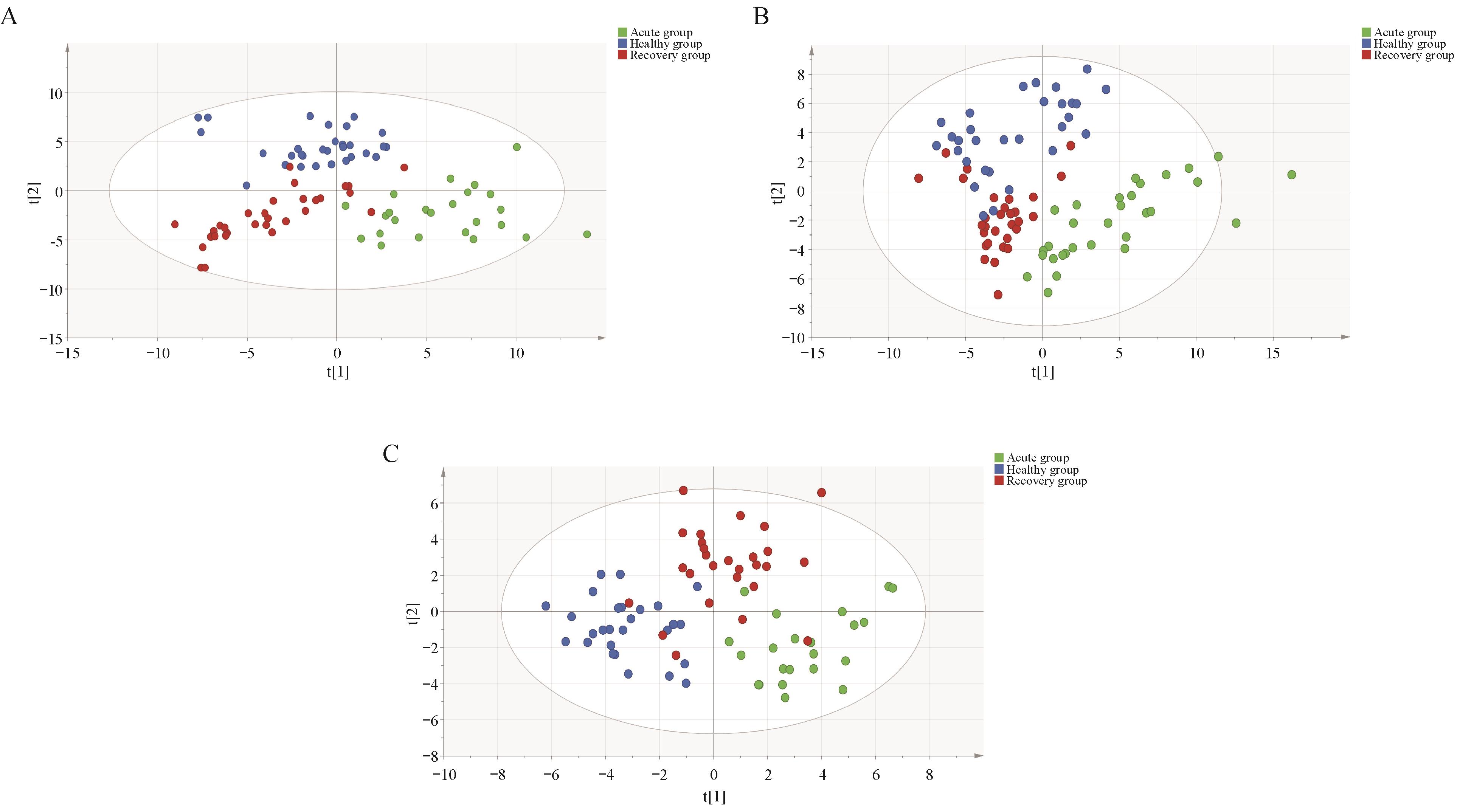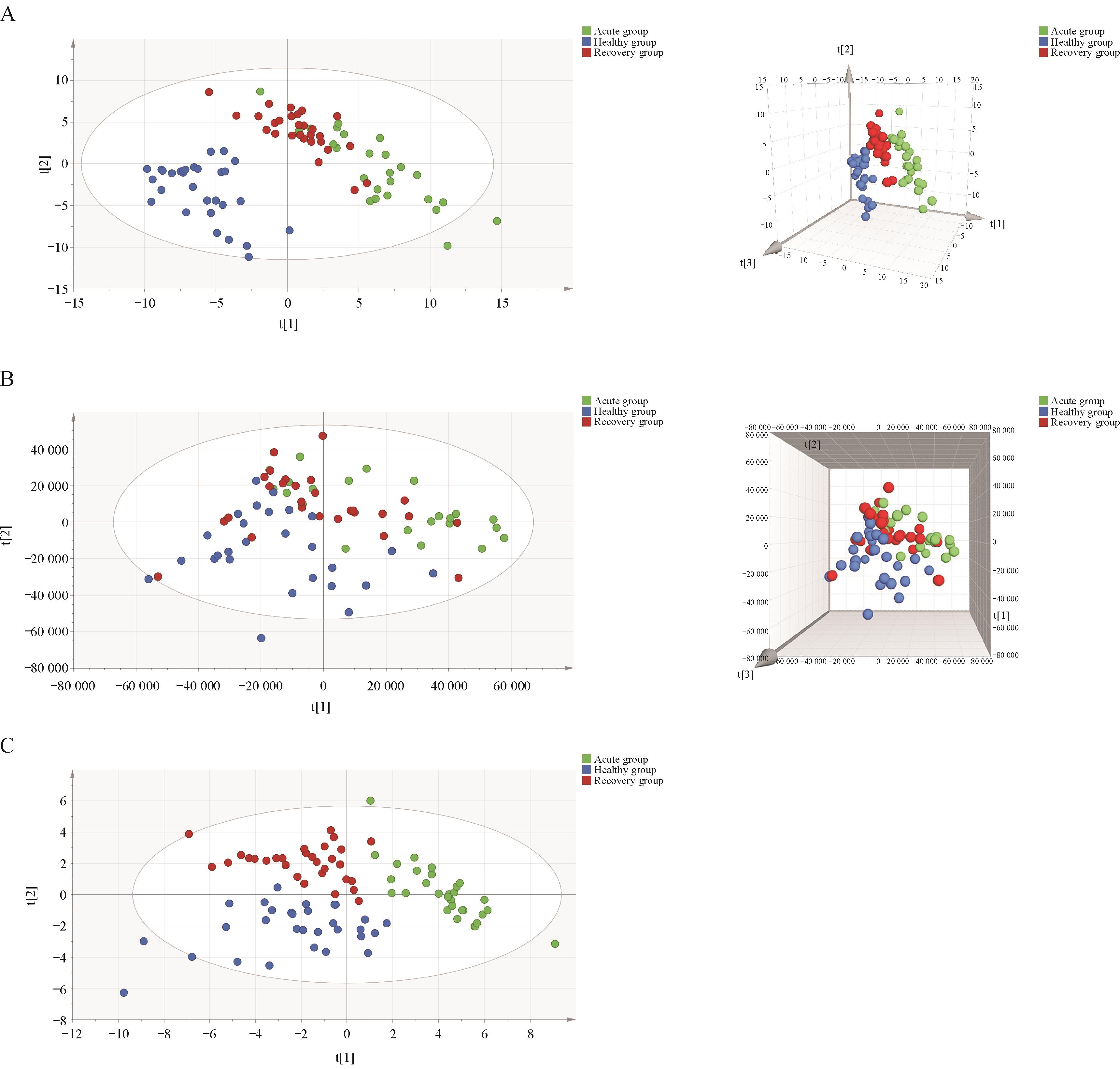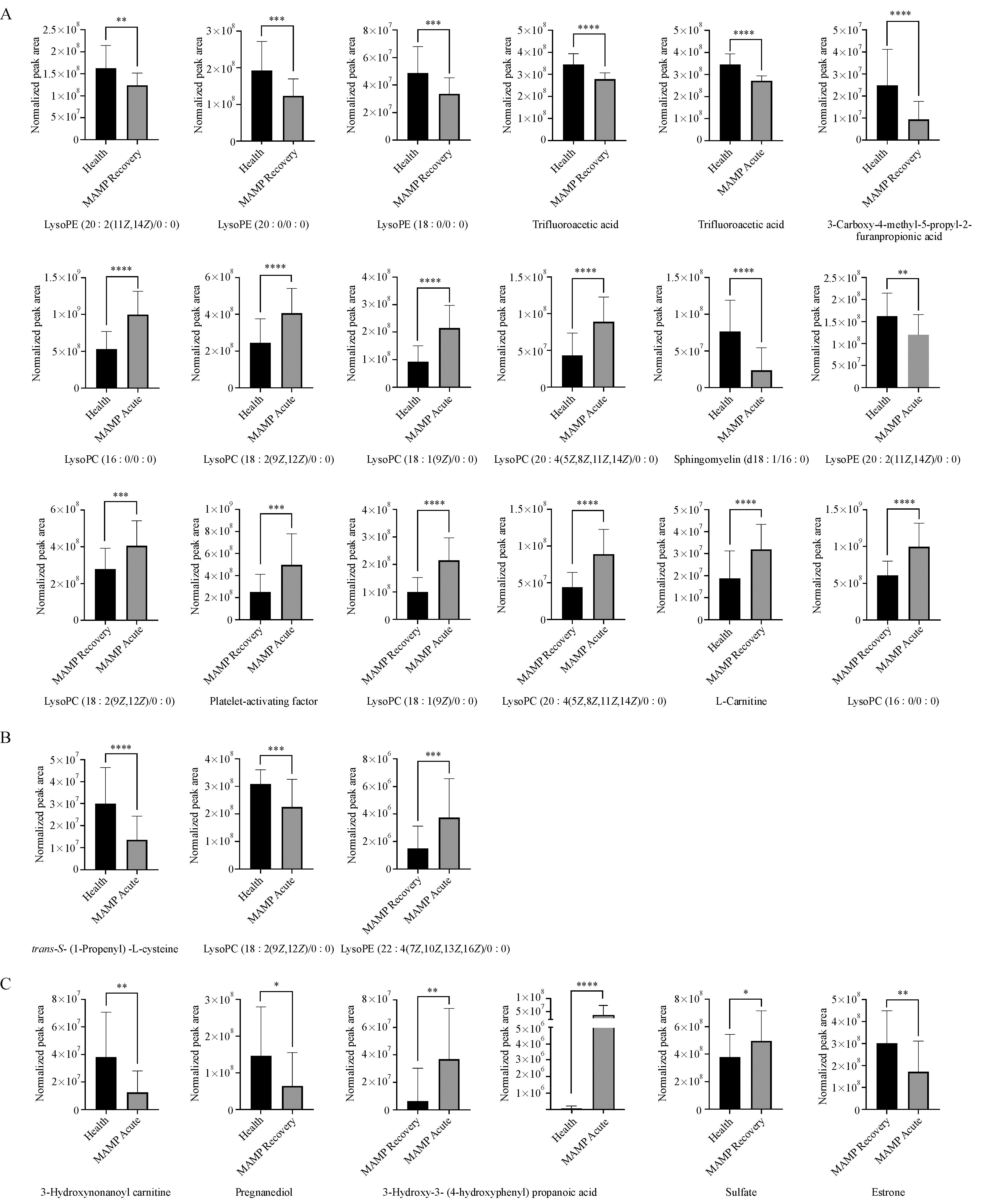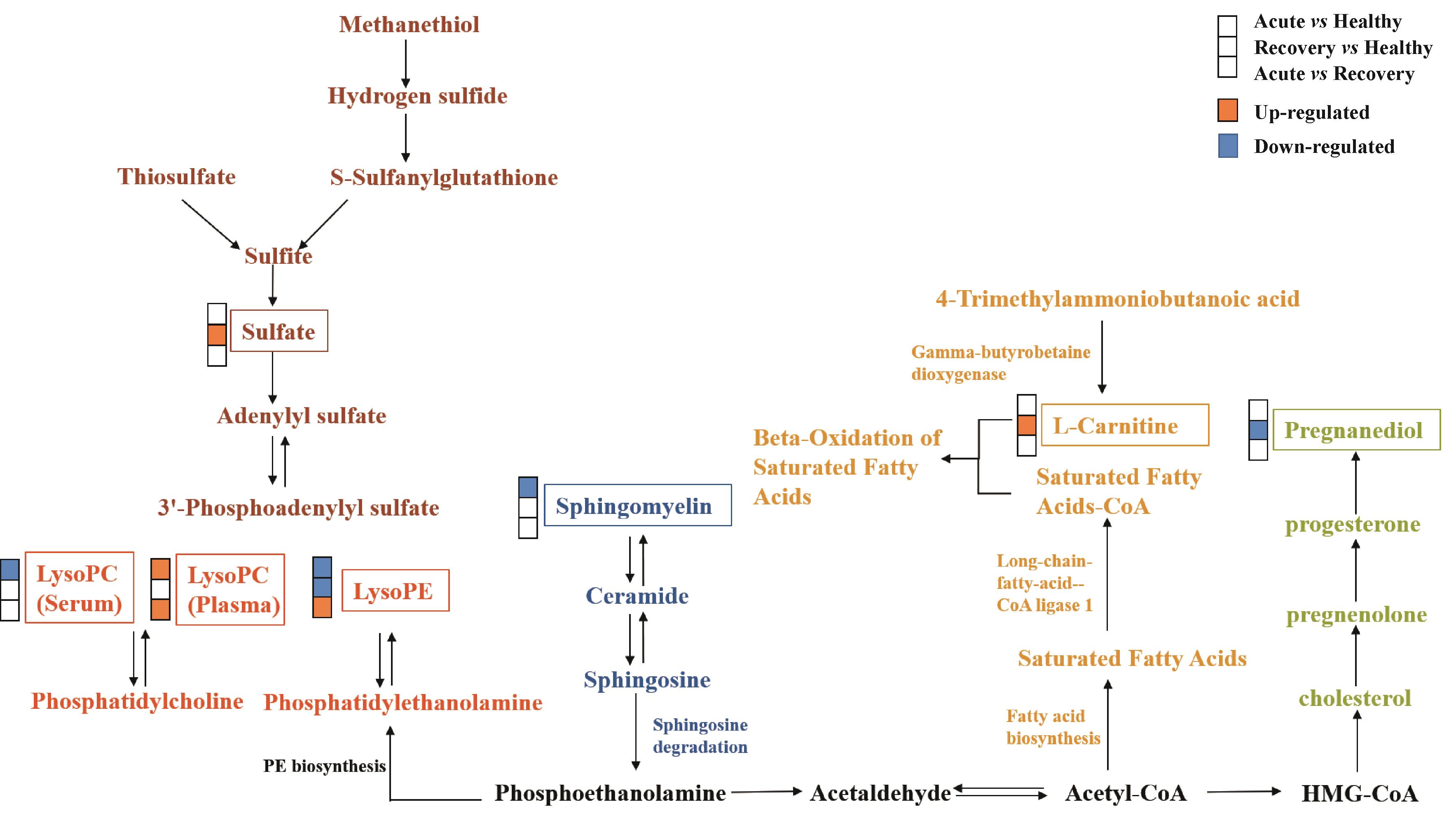摘要
甲基苯丙胺的滥用已成为全球公共卫生安全的一大隐患。为了更加科学可靠的判断甲基苯丙胺成瘾和戒毒阶段,本研究采用液相色谱-四极杆-飞行时间串联质谱(LC-QTOF-MS)分析技术,对甲基苯丙胺成瘾者、戒毒康复者和健康人的血浆、血清和尿中的内源性代谢物进行分析。运用单变量和多变量统计分析处理数据,筛选符合条件的潜在生物标志物,将鉴定后的生物标志物进行代谢物富集分析,寻找代谢物与代谢途径之间的联系。多变量统计结果表明,甲基苯丙胺急性期组、康复期组和健康组3组聚类分离明显;在血清、血浆和尿液中分别鉴定出3,18和6个差异代谢物,提示甲基苯丙胺急性期组脂质代谢异常,康复期组脂肪酸代谢、硫酸盐/亚硫酸盐代谢和性激素代谢异常。本研究筛选出的潜在生物标志物,为甲基苯丙胺临床戒毒分期提供科学依据。
甲基苯丙胺的滥用是全球公共卫生安全的一大隐
生物标志物已广泛运用于临床医学中,可通过对生物标志物的分析来对疾病进行分期,也可以作为疾病预后的指标和监测疾病对治疗的反
代谢组学通过检测细
采用病例对照研究的方法,进行甲基苯丙胺成瘾、戒毒康复者与健康人对照的代谢组学研究。试验组选择确诊的甲基苯丙胺成瘾者,分为两组,试验Ⅰ组(急性期组)为新入院甲基苯丙胺成瘾者,试验Ⅱ组(康复期组)为甲基苯丙胺成瘾戒毒康复者;对照组(健康组)为健康志愿者。试验组甲基苯丙胺成瘾者近6个月每周使用甲基苯丙胺不少于3次,滥用时间在2年以上(康复者指戒断前状况),试验Ⅰ组要求末次使用甲基苯丙胺时间不大于24 h,尿液检测甲基苯丙胺阳性;试验Ⅱ组要求甲基苯丙胺成瘾者戒毒康复6 ~ 7个月(180 d ~ 210 d);对照组要求性别年龄与试验组受试者相匹配,同性别、年龄相差不超过3岁,来源于医院体检或招募的无药物滥用史的健康受试者。收集样本信息见
本研究经北京大学生物医学伦理委员会审阅并获批准,参加试验患者均签署了知情同意书,同意参加本试验。
将血清、尿液或血浆样品在4 ℃下解冻并涡旋10 s。
血清:取冷却至4 ℃的甲醇-丙酮(9∶1)300 μL加入血清样本100 μL中,剧烈涡旋3 min,并在4 ℃下,以14 000 r/min离心15 min。取上清液100 μL在真空离心浓缩仪中挥干,并在 ‒80 ℃下保存。用水-乙腈(9∶1)100 µL复溶残渣,涡旋3 min,在4 ℃下,以14 000 r/min离心15 min,取上清液进样。
血浆:取冷却至4 ℃的甲醇-丙酮(9∶1)150 μL加入血浆样本50 μL中,剧烈涡旋3 min,后续前处理方法同血清样品。
尿液:取冷却至4 ℃的甲醇-水(1∶1)100 µL加入尿液样品50 μL中,涡旋振荡3 min,在4 ℃下以14 000 r/min离心15 min,取上清液进样。
QC:血清、血浆和尿液样品各取40 μL,分别混合后等份分装,处理方法同样品,制备成血清、血浆和尿液QC样品。
采用Agilent Eclipse Plus C18色谱柱(2.1 mm × 50 mm,1.8 μm);流动相A为水-乙腈-甲酸(95∶5∶0.1),B相为含0.1%甲酸的乙腈溶液。尿液线性梯度洗脱(A∶B):0 min(95∶5)→2 min(95∶5)→23 min(70∶30)→37 min(10∶90)→42 min(10∶90)→43 min(95∶5)→50 min(95∶5)。血浆和血清线性洗脱条件(A∶B):0 min(95∶5)→2 min(95∶5)→30 min(10∶90)→35 min(10∶90)→36 min(95∶5)→44 min(95∶5),流速为0.3 mL/min,柱温为40 ℃,尿液和血浆样品进样量为10 μL,血清样品进样量为5 µL。
将采集得到的LC-QTOF-MS数据用数据处理软件(Signpos
根据LC-QTOF-MS(ES

Figure 1 PLS-DA score plots of plasma (A), serum (B) and urine (C) detected by LC-QTOF-MS (ES
A:
根据LC-QTOF-MS(ES

Figure 2 PLS-DA score plots of plasma (A), urine (B) and serum (C) detected by LC-QTOF-MS (ES
A:
为了筛选出更加可靠的潜在生物标志物,将单变量分析和多变量分析相结合。潜在的生物标志物需满足以下条件:(1)根据OPLS-DA模型中投影变量重要性VIP(变量VIP > 1被认为对分组具有重要贡献)筛选出差异物;(2)通过S-plot(|p(corr)| > 0.5,|p| > 0.1,ES
Symbol↑ indicates up-regulations of metabolites; symbol↓ indicates down-regulations of metabolites; |p(corr)| means absolute value of the y-axis coordinate, in the S-plot is a visualization of reliability (correlation); |p| means absolute value of the x-axis coordinate, in the S-plot is a visualization of contribution (covariance)

Figure 3 Column bar graphs (mean with SD) for significantly changed metabolites detected by LC-QTOF-MS in plasma (A) and serum (B) and urine (C) Significance level is indicated with asterisks
*P< 0.05;
根据筛选出的潜在生物标志物的离子特征,选择质子化的分子和/或其他丰度最高的加合物离子作为前体离子进行MS/MS分析。将得到的MS/MS谱图与人类代谢组数据库(HMDB)中的参考标准比较。在LC-QTOF-MS(ES
与健康组相比,甲基苯丙胺急性期组血浆中溶血磷脂酰胆碱(LysoPC)(20∶4(5Z,8Z,11Z,14Z)/0∶0),LysoPC(18∶2(9Z,12Z)/0∶0),LysoPC(16∶0)/0∶0),LysoPC(18∶1(9Z)/0∶0),尿中3-羟基-3-(4-羟基苯基)丙酸水平升高;血浆中鞘磷脂(SM)(d18∶1/16∶0),三氟乙酸和溶血磷脂酰乙醇胺(LysoPE)(20∶2(11Z,14Z)/0∶0),血清中反式-S-(1-丙烯基)-L-半胱氨酸,LysoPC(18∶2(9Z,12Z)/0∶0),尿中3-羟基壬酰基肉碱水平降低。与健康组比较,甲基苯丙胺康复期组血浆中L-肉碱,尿中硫酸盐水平升高;血浆中LysoPE(20∶2(11Z,14Z)/0∶0),LysoPE(20∶0/0∶0),LysoPE(18∶0/0∶0),三氟乙酸,3-羧基-4-甲基-5-丙基-2-呋喃丙酸,尿液中孕二醇在水平降低。
与康复期组相比,甲基苯丙胺急性期组血清中LysoPE(22∶4(7Z,10Z,13Z,16Z)/0∶0),血浆中LysoPC(18∶1 (9Z)/0∶0)、LysoPC(16∶0/0∶0)、LysoPC(18∶2(9Z,12Z)/0∶0)、血小板激活因子和LysoPC(20∶4(5Z,8Z,11Z,14Z)/0∶0),尿中3-羟基壬酰基肉碱水平升高;尿中雌酮水平降低。
根据

Figure 4 Metabolite set enrichment analysis of potential biomarkers
A: Metabolite set enrichment analysis of potential biomarkers between MAMP recovery group and healthy group; B: Metabolite set enrichment analysis of potential biomarkers between MAMP acute group and recovery group.P-value (more than expected by chance within the given compound list); Enrichment Ratio = Observed hits/Expected hits.

Figure 5 Summary of metabolic pathways related to potential biomarkers. Box indicates the potential biomarkers. Orange-colored symbols indicate up-regulations of metabolites in acute group or recovery group compared with healthy group and acute group compared with recovery group, while blue-colored symbols indicate down-regulations
流行病学研究表明,精神症状的发作可能与性激素的分泌变化有
脂质代谢紊乱可能与精神分裂症有关,另外其在心血管疾病和糖尿病的发病机制中也起着至关重要的作用,脂质可能是连接精神分裂症和代谢综合征的重要生物标志
本研究采用LC-QTOF-MS技术对甲基苯丙胺成瘾者、戒毒康复者和健康人的血浆、血清和尿液进行分析,观察其代谢轮廓,发现了一些潜在的生物标志物。总的来说,上述潜在生物标志物暗示了甲基苯丙胺成瘾者的脂质代谢紊乱以及甲基苯丙胺戒毒康复者硫酸盐/亚硫酸盐代谢、脂质代谢和性激素代谢紊乱。本研究发现甲基苯丙胺康复期孕二醇和甲基苯丙胺急性期LysoPC水平异常,可能与甲基苯丙胺成瘾引起的精神症状有关。本研究为甲基苯丙胺临床戒毒分期的科学判断提供了可能性,但由于样本量较小,而潜在标志物可能会受到许多因素的影响,有必要对这些结果进行进一步验证,并对其潜在机制进行更深入的研究。
References
Courtney KE,Ray LA. Methamphetamine: an update on epidemiology,pharmacology,clinical phenomenology,and treatment literature[J]. Drug Alcohol Depend,2014,143:11-21. [百度学术]
Won S,Hong RA,Shohet RV,et al. Methamphetamine-associated cardiomyopathy[J]. Clin Cardiol,2013,36(12):737-742. [百度学术]
Kevil CG,Goeders NE,Woolard MD,et al. Methamphetamine use and cardiovascular disease[J]. Arterioscler Thromb Vasc Biol,2019,39(9):1739-1746. [百度学术]
Wodarz N,Krampe-Scheidler A,Christ M,et al. Evidence-based guidelines for the pharmacological management of acute methamphetamine-related disorders and toxicity[J]. Pharmacopsychiatry,2017,50(3):87-95. [百度学术]
Suetani S,Reddan J,Anderson C. Methamphetamine and psychiatry:a story of the colourless substance of abuse[J]. Australas Psychiatry,2017,25(3):254-256. [百度学术]
Paratz ED,Cunningham NJ,MacIsaac AI. The cardiac complications of methamphetamines[J]. Heart Lung Circ,2016,25(4):325-332. [百度学术]
Cao YY,Pu XP. Biomarkers of methamphetamine addiction and its measurements technique evolvement[J]. Chin J New Drugs(中国新药杂志),2019,28(1):34-39. [百度学术]
Mendelson J,Baggott MJ,Flower K,et al. Developing biomarkers for methamphetamine addiction[J]. Curr Neuropharmacol,2011,9(1):100-103. [百度学术]
Zaitsu K,Miyawaki I,Bando K,et al. Metabolic profiling of urine and blood plasma in rat models of drug addiction on the basis of morphine,methamphetamine,and cocaine-induced conditioned place preference[J]. Anal Bioanal Chem,2014,406(5):1339-1354. [百度学术]
Choi B,Kim SP,Hwang S,et al. Metabolic characterization in urine and hair from a rat model of methamphetamine self-administration using LC-QTOF-MS-based metabolomics[J]. Metabolomics,2017,13(10):1-17. [百度学术]
Zheng T,Liu LS,Shi J,et al. The metabolic impact of methamphetamine on the systemic metabolism of rats and potential markers of methamphetamine abuse[J]. Mol Biosyst,2014,10(7):1968-1977. [百度学术]
Zhao Y,Zhang K,Jiang HF,et al. Decreased expression of plasma microRNA in patients with methamphetamine (MA) use disorder[J]. J Neuroimmune Pharmacol,2016,11(3):542-548. [百度学术]
Alasmari F,Alsanea S,Masood A,et al. Serum proteomic profiling of patients with amphetamine use disorder[J]. Drug Alcohol Depend,2020,214:108157. [百度学术]
Shi WL,Zhao X,Liu ZM,et al. Serum proteomics of methamphetamine addicts and up-regulation of complement factor H related to methamphetamine addiction[J]. Neurosci Lett,2012,525(1):23-28. [百度学术]
Lin M,Xu JM,Liu X,et al. Metabolomics profiling of methamphetamine addicted human serum and three rat brain areas[J]. RSC Adv,2019,9(70):41107-41119. [百度学术]
Bai J,Wang MX,Chowbay B,et al. Metabolic profiling of HepG2 cells incubated with S (‒) and R(+) enantiomers of anti-coagulating drug warfarin[J]. Metabolomics,2011,7(3):353-362. [百度学术]
Cao B,Li MJ,Zha WB,et al. Metabolomic approach to evaluating adriamycin pharmacodynamics and resistance in breast cancer cells[J]. Metabolomics,2013,9(5):960-973. [百度学术]
Ouattara DA,Prot JM,Bunescu A,et al. Metabolomics-on-a-chip and metabolic flux analysis for label-free modeling of the internal metabolism of HepG2/C3A cells[J]. Mol Biosyst,2012,8(7):1908-1920. [百度学术]
Lin SH,Yang Z,Liu HD,et al. Metabolomic analysis of liver and skeletal muscle tissues in C57BL/6J and DBA/2J mice exposed to 2,3,7,8-tetrachlorodibenzo-p-dioxin[J]. Mol Biosyst,2011,7(6):1956-1965. [百度学术]
Wikoff WR,Gangoiti JA,Barshop BA,et al. Metabolomics identifies perturbations in human disorders of propionate metabolism[J]. Clin Chem,2007,53(12):2169-2176. [百度学术]
Xue RY,Lin ZX,Deng CH,et al. A serum metabolomic investigation on hepatocellular carcinoma patients by chemical derivatization followed by gas chromatography/mass spectrometry[J]. Rapid Commun Mass Spectrom,2008,22(19):3061-3068. [百度学术]
Bogdanov M,Matson WR,Wang L,et al. Metabolomic profiling to develop blood biomarkers for Parkinson's disease[J]. Brain,2008,131(Pt 2):389-396. [百度学术]
Nicholson JK,Connelly J,Lindon JC,et al. Metabonomics:a platform for studying drug toxicity and gene function[J]. Nat Rev Drug Discov,2002,1(2):153-161. [百度学术]
Häfner H,Riecher-Rössler A,An der Heiden WA,et al. Generating and testing a causal explanation of the gender difference in age at first onset of schizophrenia[J]. Psychol Med,1993,23(4):925-940. [百度学术]
Hallonquist JD,Seeman MV,Lang M,et al. Variation in symptom severity over the menstrual cycle of schizophrenics[J]. Biol Psychiatry,1993,33(3):207-209. [百度学术]
Cai HL,Li HD,Yan XZ,et al. Metabolomic analysis of biochemical changes in the plasma and urine of first-episode neuroleptic-naïve schizophrenia patients after treatment with risperidone[J]. J Proteome Res,2012,11(8):4338-4350. [百度学术]
Hermens DF,Lubman DI,Ward PB,et al. Amphetamine psychosis:a model for studying the onset and course of psychosis[J]. Med J Aust,2009,190(S4):S22-S25. [百度学术]
Tirodkar TS,Voelkel-Johnson C. Sphingolipids in apoptosis[J]. Exp Oncol,2012,34(3):231-242. [百度学术]
Law SH,Chan ML,Marathe GK,et al. An updated review of lysophosphatidylcholine metabolism in human diseases[J]. Int J Mol Sci,2019,20(5):1149. [百度学术]
Tian ZS. Effect of platelet activating factor and its receptor-dependent and receptor-independent pathway in the demyelination of central nervous system(血小板激活因子与其受体依赖及非受体依赖信号通路在中枢神经系统脱髓鞘病变中的作用研究)[D]. Changchun:Jilin University,2020. [百度学术]